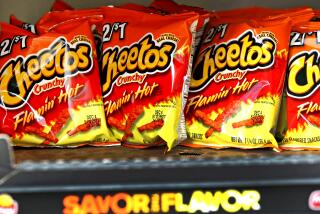Children’s Hyperactivity Traced to Diet : Nutritionist Offers Advice on Improving Youngsters’ Eating Habits
- Share via
SAN FRANCISCO — Don’t blame sugar or additives or allergies for a child’s hyperactive behavior, a nutritionist says. The real villain may be a poorly balanced diet.
About 10% of America’s 5- to 8-year-olds suffer from hyperactivity, characterized by inability to concentrate, restlessness and a short attention span, said Dr. Eleanor Whitney, author of three best-selling nutrition textbooks.
“People spend a lot of money on extensive allergy testing, natural and organic foods, vitamin supplements when a simple good diet using the four basic food groups could do the trick,” said Whitney, who was assistant professor of nutrition at Florida State University for 12 years.
“Poor nutrition certainly does affect behavior. Almost any of 20 nutrient deficiencies can render behavior abnormal,” said Whitney, who during the past eight years has reviewed more than 16,000 articles and studies on nutrition.
Iron deficiency is the most common nutrient deficiency, affecting 10% to 20% of children, said Whitney, founder of the Nutrition Co. Inc., a nutrition information center for health care professionals, in Tallahasee, Fla.
“Research clearly shows that in the early stages of iron deficiency a child can’t concentrate, is restless, has a short attention span, can’t sit still, the main characteristics associated with hyperactivity,” she said.
“Studies also show that in the brain of children with iron deficiency there is a reduction of certain enzymes involved with neurotransmitters, or important pathways in the brain that have to do with paying attention.”
In addition, iron deficiency makes a child more susceptible to lead poisoning--also shown to be connected to poor classroom performance, she said.
“Lead poisoning, which strikes one in 50 children in rural areas and one in 10 in some inner city areas, is a bigger danger to a child with iron deficiency because lead and iron compete for absorption in the digestive tract, so if there’s less iron, the lead gets in quicker,” Whitney said.
As other examples, she said, thiamin deficiency can result in confusion, uncoordinated movements, depressed appetite, irritability, insomnia, fatigue and general misery, while too little niacin can lead to depression, headaches, memory loss and emotional instability.
The symptoms may appear even before any sign of the deficiency is detectable in blood tests.
Whitney, in San Francisco on a lecture tour, said that during the past decade three culprits have been wrongly accused: food allergies, chemical additives and sugar.
“These may be attractive as offering the public a black-and-white picture of a villain, but the true picture is far more complicated,” she said.
“Parents should not be deathly afraid of sugar and forbid their children from eating all cookies and candies but should be conscious of feeding their children wholesome foods from the four groups.”
Whitney recommends the following daily diet for children:
- Milk and cheese: four servings of one-half to three-fourths cup per serving for 1-to-3-year-olds; three-fourths cup for 4-to-5-year-olds; three-fourths to 1 cup for 6-to-12-year-olds.
- Meat group: three servings, more permitted, including:
--Eggs: one for all age groups.
--Lean meat (liver once a week), fish, poultry, legumes.
--Peanut butter: 0-1 tablespoon for 1-to-3-year-olds; 2 tablespoons, 4-to-5 years; 2-3 tablespoons, 6-to-12 years.
- Fruits and vegetables: four servings, more recommended, including:
--Vitamin C source, including citrus fruits, berries, tomato, cabbage, cantaloupe: one or more servings of one-third to one-half cup for 1-to-3-year-olds; one-half cup, 4-to-5 years; one medium orange, 6-to-12 years.
--Vitamin A source, including green or yellow fruits and vegetables: one or more servings of 2-3 tablespoons for 1-to-3-year-olds; 4 tablespoons, 4-to-5 years; one-fourth to one-third cup, 6-to-12 years.
--Other vegetables, including potato: two servings of 2-3 tablespoons for 1-to-3-year-olds; 4 tablespoons, 4-to-5 years; one-third to one-half cup, 6-to-12 years.
--Other fruits, including apple, banana: one-fourth to one-third cup for 1-to-3-year-olds; one-half cup, 4-to-5 years; one medium piece, 6-to-12 years.
- Whole grain or enriched cereals: four servings, more recommended, including:
--Bread, buns, pizza: one-half to one slice for 1-to-3-year-olds; 1 1/2 slices, 4-to-5 years; 1-2 slices, 6-to-12 years.
--Ready-to-eat cereals: one-half to three-fourth ounce for 1-to-3-year-olds; 1 ounce, 4-to-12 years.
--Cooked grains, including cereals, macaroni, grits, rice: one-fourth to one-third cup for 1-to-3-year-olds; one-half cup, 4-to-5 years; one-half to three-fourths cup, 6-to-12 years.
After fulfilling these requirements, the child may be allowed limited amounts of pudding, ice cream, cookies, cake, pie, jelly, jam, honey or sugar.




